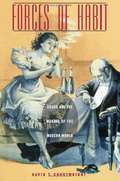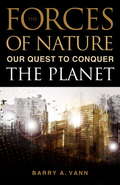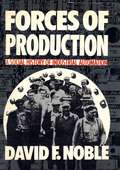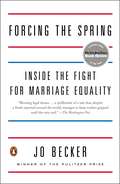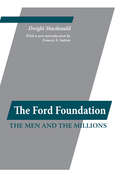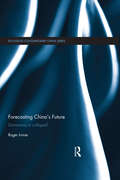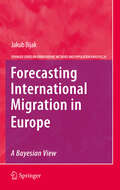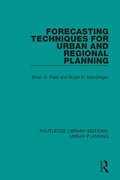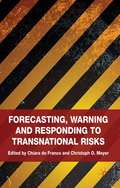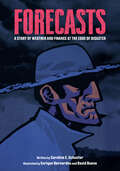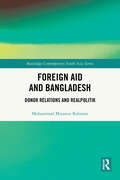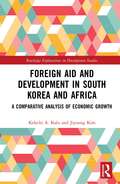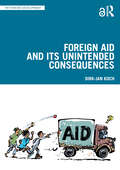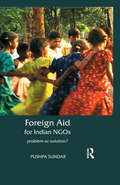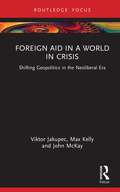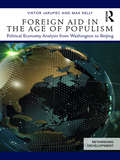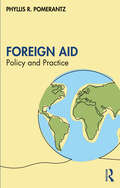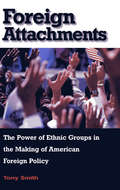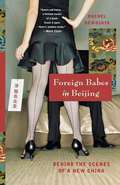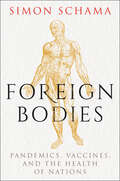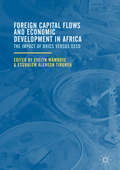- Table View
- List View
Forces of Habit: Drugs and the Making of the Modern World
by David T. CourtwrightWhat drives the drug trade, and how has it come to be what it is today? A global history of the acquisition of progressively more potent means of altering ordinary waking consciousness, this book is the first to provide the big picture of the discovery, interchange, and exploitation of the planet's psychoactive resources, from tea and kola to opiates and amphetamines.
Forces of Nature
by Barry A. VannThis illuminating overview of human population shifts and their precarious relationship with climate change and geography brings a unique perspective to understanding our age-old natural desire to inhabit picturesque landscapes or to transform once-desolate areas into new gardens of growth, all the while confronted by the dangerous, often life-threatening natural events that test our endurance. The author takes us on a journey along the ancient migration routes of our earliest ancestors and examines why many chose to settle in natural utopias with ample water; lush, fertile lands; and a moderate climate, while others were forced to make the most of far less inviting surroundings. Today, populations still shift. Some people migrate for devoutly religious reasons--outgrowing their surroundings, they move to the next available area, seeking a better life and spreading their religion--potentially instigating social conflict. We also now migrate in order to fulfill our wants and needs. Instead of settling near sources of water as a means for growth and survival, we seek out waterfront areas for their appealing landscape, though these spaces are already teeming with people. In contrast, many others are willing to move to new areas, no matter how inhospitable the clime, to earn a living. While there is still no technology that can protect vulnerable groups against the threatening features of the natural world, this book offers suggestions for how we can better adapt to challenging environments.
Forces of Production
by David F NobleFocusing on the design and implementation of computer-based automatic machine tools, David F. Noble challenges the idea that technology has a life of its own. Technology has been both a convenient scapegoat and a universal solution, serving to disarm critics, divert attention, depoliticize debate, and dismiss discussion of the fundamental antagonisms and inequalities that continue to beset America. This provocative study of the postwar automation of the American metal-working industry-the heart of a modern industrial economy-explains how dominant institutions like the great corporations, the universities, and the military, along with the ideology of modern engineering shape, the development of technology. Noble shows how the system of "numerical control," perfected at the Massachusetts Institute of Technology (MIT) and put into general industrial use, was chosen over competing systems for reasons other than the technical and economic superiority typically advanced by its promoters. Numerical control took shape at an MIT laboratory rather than in a manufacturing setting, and a market for the new technology was created, not by cost-minded producers, but instead by the U. S. Air Force. Competing methods, equally promising, were rejected because they left control of production in the hands of skilled workers, rather than in those of management or programmers. Noble demonstrates that engineering design is influenced by political, economic, managerial, and sociological considerations, while the deployment of equipment-illustrated by a detailed case history of a large General Electric plant in Massachusetts-can become entangled with such matters as labor classification, shop organization, managerial responsibility, and patterns of authority. In its examination of technology as a human, social process, Forces of Production is a path-breaking contribution to the understanding of this phenomenon in American society.
Forcing the Spring
by Jo Becker*A New York Times Notable Book of the Year** A Washington Post Best Book of the Year (Nonfiction)** A Kirkus Best Book of the Year*"[A] riveting legal drama, a snapshot in time, when the gay rights movement altered course and public opinion shifted with the speed of a bullet train... Becker's most remarkable accomplishment is to weave a spellbinder of a tale that, despite a finale reported around the world, manages to keep readers gripped until the very end." --The Washington Post A tour de force of groundbreaking reportage by Pulitzer Prize-winning journalist Jo Becker, Forcing the Spring is the definitive account of five remarkable years in American civil rights history: when the United States experienced a tectonic shift on the issue of marriage equality. Beginning with the historical legal challenge of California's ban on same-sex marriage, Becker expands the scope to encompass all aspects of this momentous struggle, offering a gripping behind-the-scenes narrative told with the lightning pace of the greatest legal thrillers. For nearly five years, Becker was given free rein in the legal and political war rooms where the strategy of marriage equality was plotted. She takes us inside the remarkable campaign that rebranded a movement; into the Oval Office where the president and his advisors debated how to respond to a fast-changing political landscape; into the chambers of the federal judges who decided that today's bans on same-sex marriage were no more constitutional than the previous century's bans on interracial marriage; and into the mindsets of the Supreme Court judges who decided the California case and will likely soon decide the issue for the country at large. From the state-by state efforts to win marriage equality at the ballot box to the landmark Supreme Court case that struck down a law that banned legally married gay and lesbian couples from receiving federal benefits, Becker weaves together the political and legal forces that reshaped a nation. Forcing the Spring begins with California's controversial ballot initiative Proposition 8, which banned gay men and lesbians from marrying the person they loved. This electoral defeat galvanized an improbable alliance of opponents to the ban, with political operatives and Hollywood royalty enlisting attorneys Ted Olson and David Boies--the opposing counsels in the Supreme Court's Bush v. Gore case--to join together in a unique bipartisan challenge to the political status quo. Despite stiff initial opposition from the gay rights establishment, the case against Proposition 8 would ultimately force the issue of marriage equality all the way to the Supreme Court, transforming same-sex marriage from a partisan issue into a modern crisis of civil rights. Based on singular access to the internal workings of this momentous trial--and enlivened by original interviews with the participants on both sides of the case, many speaking for the first time--Forcing the Spring is at once an emotion-packed tale of love and determination as well as an eye-opening examination of an evidentiary record that federal courts across the nation are now relying on to strike down bans similar to California's. Shuttling between the twin American power centers of Hollywood and Washington--and based on access to all the key players in the Justice Department and the White House--Becker offers insider coverage on the true story of how President Obama "evolved" to embrace marriage equality, his surprising role in the Supreme Court battle, and the unexpected way the controversial issue played in the 2012 elections. What starts out as a tale of an epic legal battle grows into the story of the evolution of a country, a testament and old-fashioned storytelling to move public opinion. Becker shows how the country reexamined its opinions on same-sex marriage, an issue that raced along with a snowballing velocity which astounded veteran political operatives, as public opinion on same-sex marriage flipped and elected officials repositioned themselves to adjust to a dramatically changed environment. Forcin...
Forcing the Spring: Inside the Fight for Marriage Equality
by Jo BeckerA tour de force of groundbreaking reportage by Pulitzer Prize-winning journalist Jo Becker, Forcing the Spring is the definitive account of five remarkable years in American civil rights history: when the United States experienced a tectonic shift on the issue of marriage equality. Beginning with the historical legal challenge of California's ban on same-sex marriage, Becker expands the scope to encompass all aspects of this momentous struggle, offering a gripping behind-the-scenes narrative told with the lightning pace of the greatest legal thrillers.<P> For nearly five years, Becker was given free rein in the legal and political war rooms where the strategy of marriage equality was plotted. She takes us inside the remarkable campaign that rebranded a movement; into the Oval Office where the president and his advisors debated how to respond to a fast-changing political landscape; into the chambers of the federal judges who decided that today's bans on same-sex marriage were no more constitutional than the previous century's bans on interracial marriage; and into the mindsets of the Supreme Court judges who decided the California case and will likely soon decide the issue for the country at large. From the state-by state efforts to win marriage equality at the ballot box to the landmark Supreme Court case that struck down a law that banned legally married gay and lesbian couples from receiving federal benefits, Becker weaves together the political and legal forces that reshaped a nation.<P> Forcing the Spring begins with California's controversial ballot initiative Proposition 8, which banned gay men and lesbians from marrying the person they loved. This electoral defeat galvanized an improbable alliance of opponents to the ban, with political operatives and Hollywood royalty enlisting attorneys Ted Olson and David Boies--the opposing counsels in the Supreme Court's Bush v. Gore case--to join together in a unique bipartisan challenge to the political status quo. Despite stiff initial opposition from the gay rights establishment, the case against Proposition 8 would ultimately force the issue of marriage equality all the way to the Supreme Court, transforming same-sex marriage from a partisan issue into a modern crisis of civil rights. Based on singular access to the internal workings of this momentous trial--and enlivened by original interviews with the participants on both sides of the case, many speaking for the first time--Forcing the Spring is at once an emotion-packed tale of love and determination as well as an eye-opening examination of an evidentiary record that federal courts across the nation are now relying on to strike down bans similar to California's.<P> Shuttling between the twin American power centers of Hollywood and Washington--and based on access to all the key players in the Justice Department and the White House--Becker offers insider coverage on the true story of how President Obama "evolved" to embrace marriage equality, his surprising role in the Supreme Court battle, and the unexpected way the controversial issue played in the 2012 elections.<P> What starts out as a tale of an epic legal battle grows into the story of the evolution of a country, a testament and old-fashioned storytelling to move public opinion. Becker shows how the country reexamined its opinions on same-sex marriage, an issue that raced along with a snowballing velocity which astounded veteran political operatives, as public opinion on same-sex marriage flipped and elected officials repositioned themselves to adjust to a dramatically changed environment. Forcing the Spring is the ringside account of this unprecedented change, the fastest shift in public opinion ever seen in ...
Ford Foundation
by Dwight MacdonaldThirty years since it was first published, Macdonald's masterful book on the Ford Foundation remains the only book-length account of this institution that has been published. Despite the calls for a book carrying on the story from 1956 on the part of Richard Magat and McGeorge Bundy, that book has yet to be written. In his stimulating introduction to this new edition, Francis Sutton suggests why this is so. The Foundation, he observes, has never again aroused as much public interest as it did in the years Macdonald's describes. The announcement that a new program would be launched with the riches that 90 percent of the Ford Motor Company's stock would bring captured the attention of the media all across the country. Its sheer size was astounding; in 1954 the Ford Foundation spent four times as much as the Rockefeller Foundation and ten times as much as the Carnegie Corporation. Its expenditures were very large in relation to the budgets of the institutions that looked to it for help. Consequently, the American public waited expectantly to see what this huge foundation would do. But the Ford Foundation was not only big; it was controversial in those years, and inspired activism in the media, Congressional investigations, and political wrath. Macdonald nicely captures the American ambivalence toward large bureacratic organizations, which the Ford Foundation epitomizes, with its own language and, one might argue, its own values. Sutton points out that Macdonald's writing also sets a model for foundation history and indeed philanthropic history, with a poised, ironic detachment that has remained rare. His introduction points out the main themes of Macdonald's book and examines the extent to which they continue to illumine the foundation in the years since this book was first published. It looks at how well the Foundation has addressed the objectives it set for itself, and nicely captures the giant changes that this giant foundation has experienced through the 1960s and 1970s, to the present day.
Forecasting China's Future: Dominance or Collapse? (Routledge Contemporary China Series)
by Roger IrvineChina’s future development is likely to have a huge impact on twenty-first century global outcomes. It is therefore surprising that, thus far, so little attention has been given to comparing and evaluating expert forecasts of China’s future in the post-Mao era. This book presents an illuminating and comprehensive summary record of contrasting and competing expert forecasts and judgements about the major issues confronting China within four principal domains – political, economic, environmental, and international. After considering the principal forecasting methods available to experts, the author comments critically on the degree of success achieved in using those methods and emphasises the confusion created by the polarisation of opinion and by the failure of many experts to accept the high degree of uncertainty that characterises most of the key issues. The book recommends a new approach based on the study of a hierarchy of critical uncertainties and on continuing analysis of opposing expert opinions about these uncertainties. It emphasises the potential for both positive and negative outcomes for these critical uncertainties, and the importance of maximising the potential for positive outcomes through improved analytical and policy frameworks. Providing insights for specialists and non-specialists into the most critical issues that will determine China’s future direction, this book will be of particular interest to students and scholars of political, economic, environmental, and international relations issues in China and Asia, as well as to readers in business and government.
Forecasting International Migration in Europe: A Bayesian View
by Arkadiusz Wisniowski Jakub BijakInternational migration is becoming an increasingly important element of contemporary demographic dynamics and yet, due to its high volatility, it remains the most unpredictable element of population change. In Europe, population forecasting is especially difficult because good-quality data on migration are lacking. There is a clear need for reliable methods of predicting migration since population forecasts are indispensable for rational decision making in many areas, including labour markets, social security or spatial planning and organisation. In addressing these issues, this book adopts a Bayesian statistical perspective, which allows for a formal incorporation of expert judgement, while describing uncertainty in a coherent and explicit manner. No prior knowledge of Bayesian statistics is assumed. The outcomes are discussed from the point of view of forecast users (decision makers), with the aim to show the relevance and usefulness of the presented methods in practical applications.
Forecasting Techniques for Urban and Regional Planning (Routledge Library Editions: Urban Planning #11)
by Brian FieldOriginally published in 1987, Forecasting Techniques for Urban and Regional Planning is an introduction to the various analytical techniques which have been developed and applied in urban and regional analysis in planning practice. The subjects covered are population, housing, employment, transport, shopping, recreation, and integrated forecasting. Each technique, placed in the context of policy formulation and political matters, is presented both verbally and mathematically, and it separating characteristic is illustrated with detailed but simple practical examples. The techniques examined are set in a policy context and their practical limitations are identified.
Forecasting, Warning and Responding to Transnational Risks
by Chiara De Franco Christoph O. MeyerAssembling a high profile group of scholars and practitioners, this book investigates the interplay of forecasting; warnings about, and responses to, known and unknown transnational risks. It challenges conventional accounts of 'failures' of warning and preventive policy in both the academic literature and public debate.
Forecasts: A Story of Weather and Finance at the Edge of Disaster (ethnoGRAPHIC)
by Caroline SchusterBased in the agrarian world of commercial sesame farming in northern Paraguay, Forecasts tells a story about what happens when global insurance companies promise financial safety nets to local farmers struggling with the effects of climate change. This striking graphic novel brings together original ethnographic research and Paraguayan gothic art to confront the limitations of finance to respond to a deteriorating environment. Taking a human-centered approach to complex weather and financial models, Forecasts offers new ways of looking at overlapping speculative futures in a more-than-human landscape. Based on more than a year of fieldwork in Paraguay, the book follows one man’s possible journeys through a season of planting and harvesting, buffeted by losses and sustained by the hope that he can cultivate conditions that will help his family thrive. Forecasts makes a sweeping account of environmental and financial risk accessible through the intimate story of one family’s triumphs, heartbreaks, and hopes for the future.
Foreign Aid and Bangladesh: Donor Relations and Realpolitik (Routledge Contemporary South Asia Series)
by Mohammad Mizanur RahmanForeign Aid and Bangladesh offers a rich combination of aid history – from the evolution of aid as a global agenda after WWII to the rise of different multilateral, bilateral, and emerging donors and their policy shifts – and a nuanced perspective of aid partnerships at the country level. Drawing on first-hand experiences and insights, the author deeply investigates the realities of a longstanding aid recipient, Bangladesh, and argues that without a political economy approach, one cannot understand the realpolitik of development aid. As an emerging economy from the global south, Bangladesh has been a longstanding partner and recipient of international aid since 1971. Bangladesh has also been active in the global discussions leading to redefining the new narrative and arguments for the new aid regime since the beginning of this century. Building on the analysis of Bangladesh's aid relations, the book shows that there has not been any qualitative shift in aid behavior in the new aid regime that set new norms after the end of the Cold War to ensure recipients' ownership and welcomed an expanding aid landscape by integrating emerging economies from the Global South for achieving better development results. The book analyzes the role of different actors in the development partnership, both traditional and emerging donors - such as China and India, and their partnership practices. It examines different forms of aid and their changing perspective, particularly technical assistance. Based on more than two decades of research and profound insider observations, the book debunks the myth that Southern providers could be more benign to their partners. The arguments placed in the book expose that there is no difference between traditional and emerging donors in ensuring donors' business and strategic interests. While donors continue to ensure their interests in providing aid, the Realpolitik of the situation in the recipient country shows that there is a specific economic and political agenda in pursuing aid. Presenting a comprehensive picture of Bangladesh's aid partnership, through the lens of new development partnership principles and narratives of development aid, this book will be of interest to scholars and researchers of aid and development studies and political science as well as South Asian Studies. Donor officials, civil servants, and national and international policy communities will also benefit from this book.
Foreign Aid and Development in South Korea and Africa: A Comparative Analysis of Economic Growth (Routledge Explorations in Development Studies)
by Kelechi A. Kalu Jiyoung KimThis book compares the rapid development of South Korea over the past 70 years with selected countries in sub-Saharan Africa to assess what factors contributed to the country’s success story, and why it is that countries that were comparable in the past continue to experience challenges in achieving and sustaining economic growth. In the 1950s, South Korea’s GDP per capita was $876, roughly comparable with that of Cote d’Ivoire and somewhat below Ghana’s. The country’s subsequent transformation from a war-ravaged, international aid-dependent economy to the 13th largest economy in the world has been the focus of considerable international admiration and attention. But how was it that South Korea succeeded in multiplying its GDP per capita by a factor of 23, while other Less Developed Countries continue to experience challenges? This book compares South Korea’s politics of development and foreign assistance with that of Ghana, Nigeria, and Zambia, which were also major recipients of the U.S. aid, to investigate the specific contexts that made it possible for South Korea to achieve success. Overall, this book argues that effective state capacity in South Korea’s domestic and international politics provided an anchor for diplomatic engagement with donors and guided domestic political actors in the effective use of aid for economic development. This book will be of interest to researchers and students working on development, comparative political economy, and foreign aid, and to policy makers and practitioners looking for a greater understanding of comparative development trajectories.
Foreign Aid and Economic Growth: A Theoretical and Empirical Investigation (Routledge Revivals)
by Janine L. BowenPublished in 1998, this book provides an empirical analysis of the impact of foreign economic aid in 67 developed countries over a 19 year period. The results include the relationships between aid and growth and the implication that methodologies traditionally used have been largely responsible for inconsistent findings in the past.
Foreign Aid and Its Unintended Consequences (Rethinking Development)
by Dirk-Jan KochForeign aid and international development frequently bring with it a range of unintended consequences, both negative and positive. This book delves into these consequences, providing a fresh and comprehensive guide to understanding and addressing them. The book starts by laying out a theoretical framework based on complexity thinking, before going on to explore the ten most prevalent kinds of unintended effects of foreign aid: backlash effects, conflict effects, migration and resettlement effects, price effects, marginalization effects, behavioural effects, negative spillover effects, governance effects, environmental effects, and ripple effects. Each chapter revolves around a set of concrete case studies, analysing the mechanisms underpinning the unintended effects and proposing ways in which policymakers, practitioners, and evaluators can tackle negative side effects and maximize positive side effects. The book also includes personal testimonies, a succinct overview of unintended effects, and suggestions for further reading. Providing a clear overview of what side effects to anticipate when planning, executing, and evaluating aid, this book will be an important resource for students, development practitioners, and policymakers alike.
Foreign Aid and Its Unintended Consequences (Rethinking Development)
by Dirk-Jan KochForeign aid and international development frequently bring with it a range of unintended consequences, both negative and positive. This book delves into these consequences, providing a fresh and comprehensive guide to understanding and addressing them.The book starts by laying out a theoretical framework based on complexity thinking, before going on to explore the ten most prevalent kinds of unintended effects of foreign aid: backlash effects, conflict effects, migration and resettlement effects, price effects, marginalization effects, behavioural effects, negative spillover effects, governance effects, environmental effects, and ripple effects. Each chapter revolves around a set of concrete case studies, analysing the mechanisms underpinning the unintended effects and proposing ways in which policymakers, practitioners, and evaluators can tackle negative side effects and maximize positive side effects. The book also includes personal testimonies, a succinct overview of unintended effects, and suggestions for further reading.Providing a clear overview of what side effects to anticipate when planning, executing, and evaluating aid, this book will be an important resource for students, development practitioners, and policymakers alike.The Open Access version of this book, available at http://www.taylorfrancis.com, has been made available under a Creative Commons Attribution-Non Commercial-No Derivatives (CC-BY-NC-ND) 4.0 license.
Foreign Aid for Indian NGOs: Problem or Solution?
by Pushpa SundarThis book explores what difference development aid has made to the size, complexity, style of functioning, values and future direction of the NGO sector in India. It does this, first, by giving a comprehensive documentation of the experience of Indian NGOs with foreign aid since Independence. Simultaneously, it also analyses, in a broad historical perspective, some of the issues which are the subject of contemporary debate regarding the voluntary sector and aid, such as who decides ‘what’ is development and ‘how’ it should be brought about; whether foreign donors have hidden agendas, and if their aid amounts to cultural imperialism; and whether aid has made NGOs more self-reliant.The book also looks at the tripartite relationship between NGOs, donors, and governments, examining, for instance, whether the government is justified in imposing restrictions on receipt of funds by NGOs on the grounds that terrorist activities and religiously motivated communal strife are often financed with funds from abroad, with NGOs being used as fronts for both.
Foreign Aid in a World in Crisis: Shifting Geopolitics in the Neoliberal Era (Routledge Explorations in Development Studies)
by Viktor Jakupec John McKay Max KellyThis book investigates the geopoliticisation of foreign aid in recent years, against a background of global overarching crises such as climate change, conflict, Covid-19, economic crisis, energy shortages and migration.Foreign aid has historically been understood as assisting both with the development objectives of the recipients and with the trade and geopolitical interests of the donors. In the first decades of the 21st century, however, this balance has been shifted by a series of complex global challenges. This book argues that donors have now moved towards framing aid as a geopolitical instrument, wherein aid can be given or withheld based on power or political intent, thus imposing the donor’s specific values and norms. This book provides an in-depth analysis of this weaponisation of foreign aid within a framework of global disruption and ultimately concludes that the world is at a tipping point towards a new socio-political world order.Asking important questions about the power dynamics at play within the aid sector, this book will be an important read for researchers across development studies, political science, international relations and global affairs.
Foreign Aid in the Age of Populism: Political Economy Analysis from Washington to Beijing (Rethinking Development)
by Viktor Jakupec Max KellyAcross the world the Western dominated international aid system is being challenged. The rise of right-wing populism, de-globalisation, the advance of illiberal democracy and the emergence of non-Western donors onto the international stage are cutting right to the heart of the entrenched neoliberal aid paradigm. Foreign Aid in the Age of Populism explores the impact of these challenges on development aid, arguing that there is a need to bring politics back into development aid; not just the politics of economics, but power relations internally in aid organisations, in recipient nations, and between donor and recipient. In particular, the book examines how aid agencies are using Political Economy Analysis (PEA) to inform their decision making and to push aid projects through, whilst failing to engage meaningfully with wider politics. The book provides an in-depth critical analysis of the Washington Consensus model of political economy analysis, contrasting it with the emerging Beijing Consensus, and suggesting that PEA has to be recast in order to accommodate new and emerging paradigms. A range of alternative theoretical frameworks are suggested, demonstrating how PEA could be used to provide a deeper and richer understanding of development aid interventions, and their impact and effectiveness. This book is perfect for students and researchers of development, global politics and international relations, as well as also being useful for practitioners and policy makers within government, development aid organisations, and global institutions.
Foreign Aid: Policy and Practice
by Phyllis R. PomerantzForeign Aid: Policy and Practice offers a complete overview of the basics of foreign aid. Who is it for? Who pays for it? Why does it exist? What is it spent on? How much is it? And most important, does it work? The aid debate has been flooded by academic studies and popular books that either challenge or champion the effectiveness of aid. Most presume that the reader already knows the basic facts and characteristics of the aid industry. This book provides readers with a comprehensive summary of the background, actors, core principles and policies, and intended (and unintended) outcomes of foreign aid, followed by a more informed and balanced treatment of the key controversies and trends in aid today. Drawing on the author’s 25 years’ experience in development practice and 15 years in teaching, the book reflects on recent efforts to accelerate aid’s impact and concludes by taking a look at the future of aid and the headwinds it will face in the first half of the 21st century. Perfect for university teaching at advanced undergraduate and graduate levels, this book will also encourage development practitioners, policy makers, and members of the public to engage in more informed debates about aid and development finance.
Foreign Attachments: The Power of Ethnic Groups in the Making of American Foreign Policy
by Tony SmithWho speaks for America in world affairs? In this insightful new book, Tony Smith finds that, often, the answer is interest groups, including ethnic ones. This seems natural in a country defined by ethnic and cultural diversity and a democratic political system. And yet, should not the nation's foreign policy be based on more general interests? On American national interests? In exploring this question, Smith ranges over the history of ethnic group involvement in foreign affairs; he notes the openness of our political system to interest groups; and he investigates the relationship between multiculturalism and U.S. foreign policy. The book has three major propositions. First, ethnic groups play a larger role in the formulation of American foreign policy than is widely recognized. Second, the negative consequences of ethnic group involvement today outweigh the benefits this activism at times confers on America in world affairs. And third, the tensions of a pluralist democracy are particularly apparent in the making of foreign policy, where the self-interested demands of a host of domestic actors raise an enduring problem of democratic citizenship--the need to reconcile general and particular interests.
Foreign Babes in Beijing: Behind the Scenes of a New China
by Rachel DewoskinA smart, funny, insightful peek into modern China through the eyes of a "foreign babe." "For a real insider's look at life in modern China, readers should turn to Rachel DeWoskin."-Sophie Beach, The Economist. Determined to broaden her cultural horizons and live a "fiery" life, twenty-one-year-old Rachel DeWoskin hops on a plane to Beijing to work for an American PR firm based in the busy capital. Before she knows it, she is not just exploring Chinese culture but also creating it as the sexy, aggressive, fearless Jiexi, the starring femme fatale in a wildly successful Chinese soap opera. Experiencing the cultural clashes in real life while performing a fictional version onscreen, DeWoskin forms a group of friends with whom she witnesses the vast changes sweeping through China as the country pursues the new maxim, "to get rich is glorious." In only a few years, China's capital is transformed. With "considerable cultural and linguistic resources" (The New Yorker), DeWoskin captures Beijing at this pivotal juncture in her "intelligent, funny memoir" (People), and "readers will feel lucky to have sharp-eyed, yet sisterly, DeWoskin sitting in the driver's seat"(Elle). Reading group guide included.
Foreign Bodies: Pandemics, Vaccines, and the Health of Nations
by Simon SchamaA vibrant cultural history investigating the tangled and complex history of pandemics and vaccines, by bestselling author and historian Simon SchamaCities and countries engulfed by panic and death, desperate for vaccines but fearful of what inoculation may bring. This is what the world has just gone through with Covid-19. But as Simon Schama shows in his epic history of vulnerable humanity caught between the terror of contagion and the ingenuity of science, it has happened before. Characteristically, Schama’s message is delivered through gripping, page-turning stories set in the eighteenth and nineteenth centuries: smallpox strikes London; cholera hits Paris; plague comes to India. Threading through the scenes of terror, suffering and hope – in hospitals and prisons, palaces, and slums – are an unforgettable cast of characters: a philosopher-playwright burning up with smallpox in a country chateau; a vaccinating doctor paying house calls in Halifax; a woman doctor in south India driving her inoculator-carriage through the stricken streets as dead monkeys drop from the trees. But we are also in the labs when great, life-saving breakthroughs happen, in Paris, Hong Kong, and Mumbai. At the heart of it all is an unsung hero: Waldemar Haffkine, a gun-toting Jewish student in Odesa turned microbiologist at the Pasteur Institute, hailed in England as “the saviour of mankind” for vaccinating millions against cholera and bubonic plague in British India while being cold-shouldered by the medical establishment of the Raj. Creator of the world’s first mass production line of vaccines in Mumbai, he is tragically brought down in an act of shocking injustice. Foreign Bodies crosses borders between east and west, Asia and Europe, the worlds of rich and poor, politics and science. Its thrilling story carries with it the credo of its author on the interconnectedness of humanity and nature; of the powerful and the people. Ultimately, Schama says, as we face the challenges of our times together, “there are no foreigners, only familiars.”
Foreign Bodies: Performance, Art, and Symbolic Anthropology
by A. David NapierIn five wide-ranging essays, A. David Napier explores the ways in which the foreign becomes literally and metaphorically embodied as a part of cultural identity rather than being seen as something outside it. Pre-classical Greece, Baroque Italy, and Western postmodernism are among the artistic domains Napier considers, while the symbolic terrain ranges from Balinese cosmography to body symbolism in biomedicine.
Foreign Capital Flows and Economic Development in Africa
by Evelyn Wamboye Esubalew Alehegn TirunehThis collection examines the extent to which foreign capital from conventional (OECD countries) and non-conventional (BRICS) sources has impacted economic development in Africa over the last two decades. It provides in-depth analyses of the nature, motives, and implications of this capital, and identifies drivers of contemporary rapid growth within and across African countries. Authored by leading experts, the book offers original insights for academics, policymakers, and practitioners studying the changes taking place in Africa as the continent strides more confidently toward integration with the global economy. The major themes addressed in this book include: * The implications of growing Chinese engagement in Africa * BRICS countries' versus OECD countries' investment contributions to Africa * The politics of land, land grab, and the puzzle of inclusive development in Africa * Foreign research and development spillovers, trade linkages, and productivity in Africa * Foreign aid effects on social sector, growth, and structural change in Africa * Remittances, foreign debt, resource management, and economic development in Africa
